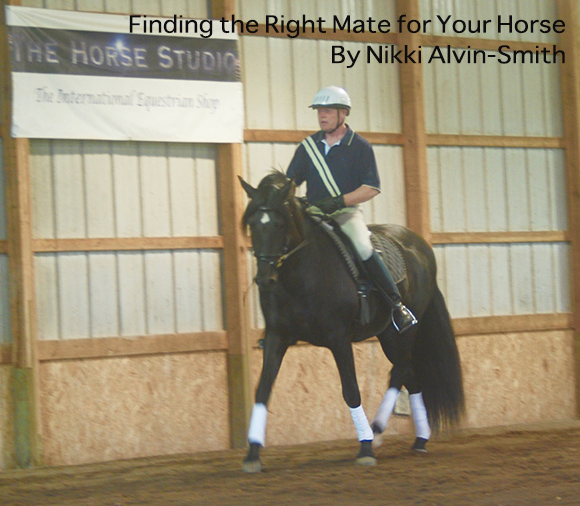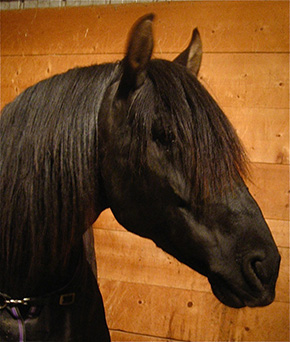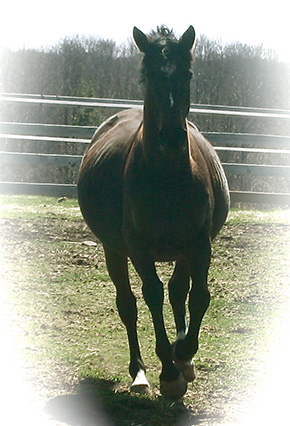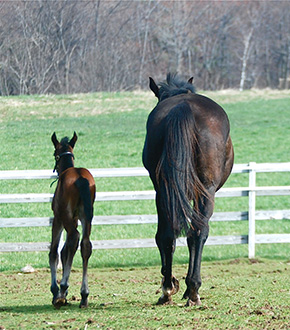Finding the Right Mate for Your Horse
By Nikki Alvin-Smith

January and February are the prime months for stallion selection in the horse breeding world. Thoroughbred farms are busy with foals hitting the floor already and the other breeds are not far behind. In our region of Upstate New York, most sporthorse breeders like to try and orchestrate early Spring foals to allow the babies maximum time on grass to develop before the next Winter. If you are breeding the same mare year over year of course this won’t be possible, as each year the available breeding cycle will become later and later.
When you consider breeding your mare it is imperative that you look keenly at your reasons for wishing to do so. You do not want to add to the glut of horses that cannot find homes and end up in kill pens or horse rescues. Regardless of whether your mare is a highly prized papered States Premium Hanoverian or a grade mare in your backyard that you’d like to try and replicate for another home mount you should answer this question with honesty. It is probably cheaper and definitely faster to purchase a new horse than to breed one. You have the added benefit of being able to choose breed, gender, color, temperament and conformation. Also breeding your mare to a stallion is not going to produce a clone version of your mare.
As a breeder of Hanoverians, Dutch Warmbloods, Andalusians and Lusitanos for nearly thirty years I am perhaps somewhat biased toward the joys and excitement of breeding horses. There are several areas of horse breeding that the neophyte breeder needs to be cognizant about before galloping into this vast field of stallion selection. Here are a few pointers:-
The Stallion
 If your mare is papered and registered as a breeding candidate then you may wish to stay within the breed in your stallion selection. Check with the registry that your mare’s paperwork is up to date and that the progeny will be eligible for registration before you begin. Your mare may be papered but may need to undergo a performance test or inspection before her foals can be considered for registration. This is easiest done before she is in foal not with a foal by her side.
If your mare is papered and registered as a breeding candidate then you may wish to stay within the breed in your stallion selection. Check with the registry that your mare’s paperwork is up to date and that the progeny will be eligible for registration before you begin. Your mare may be papered but may need to undergo a performance test or inspection before her foals can be considered for registration. This is easiest done before she is in foal not with a foal by her side.
Registered foals generally sell for more money than those unregistered so if you are breeding for resale this may be important. There are significant costs associated with this registration process so add these costs to your bottom line if this is a business venture.
The stallion himself should be viewed based on his conformation and temperament and his suitability for the discipline in which you wish the foal to succeed. The European registries do a fine job of keeping track of the performance records of all stallion and mare progeny and these can be a good resource from which to start and to learn which bloodline crosses seem to work most successfully.
The USEF also has breeding data you can resource, as does each discipline they administrate. You can also ask stallion owners for their own data on progeny of the stallion. Bear in mind these claims should be verified as while most stallion owners are honest some sadly are not.
Whenever possible visit the stallion to meet him. Watch him move at all three gaits and see him ridden if possible. Check his conformation for flaws (which can be hidden on videos with clever editing), and evaluate his temperament. If your mare is more phlegmatic by nature a hotter or more energetic stallion may suit well and vice versa. If you are breeding for yourself be honest about what you can handle at home and how much horse you want to ride. If you are selling horses to the amateur market you may not want a horse that overwhelms in gaits but the temperament will be key. Of course there is the saying, “ Breed the best to the best and hope for the best,” but choosing what is the best is subjective. The best for what? Be realistic in your goals and do not waiver.
A visit to meet the stallion is also a great opportunity for you to meet the stallion handler/owners. The breeding will involve the exchange of money from your pocket to theirs and will also require a high degree of cooperation. If you find the owner/management unhelpful, arrogant or offhand or simply don’t get along with them, then pass it up. There is always another stallion, and you should feel the breeding of your mare is taken seriously and that you are working in collaboration with the stallion owners.
A stallion will generally throw his head and neck on to the foal, particularly if it is a colt. You must look at the conformation of your mare with a critical eye. If she has a long back do not breed her to a stallion with a long back or to a stallion that produces long backed progeny. Try and mitigate the length of back by breeding to a medium length backed horse. Look at all the separate conformational parts of both horses and then look at the picture as a whole. Stallions with a good stamp (ones that throw many of their characteristics across a variety of mares) often showcase line breeding in their pedigree. It is important to look closely at the line breeding in both the mare and the stallion. Three generations or more of the same bloodlines on one line in the pedigree can produce a great stamp on progeny but it can also result in an explosion of negative characteristics in progeny as line breeding will amplify both good and bad traits.
It is also important not to shop for fashionable or popular stallion names. Do not be blinded by what is currently popular because by the time your foal is ready for saddling and showing the trends may have changed. Also just because a stallion has done well in competition himself it does not mean that he will have any ability to throw his talents on to his babies. Always look at the progeny that the stallion has produced on the floor himself. There should be plenty of videos of foals he has produced that you can examine. Look for a horse with three good balanced gaits. The breeding fees/stud fees for a stallion without progeny on the floor will be cheaper than those of a proven stallion for good reason. It is more of a gamble for the breeder as the results are totally unknown.
Be aware that mares will throw more than 65% of their characteristics onto the foal. The mare is nearly always a stronger genetic influence.
Breeding Method
The Thoroughbred industry requires live cover and this method is often credited with producing a higher percentage of colts versus fillies than artificial insemination (AI). However, in the general market AI is the most common method. You may be able to send your mare out to the stallion owner for live cover breeding, either in the field or in hand live cover, but be aware this poses greater risks of infection and injury to your mare.
Some stallions tend to throw more girls than boys especially via artificial insemination (AI). This is thought to be due to the morphology and motility of the semen. It is supposed that male semen have a shorter lifespan and are more prone to damage during transit, and may be more negatively affected by extenders used in AI. There is a lot of scientific data on this topic, which is beyond the scope of this article, but it is something of which to be aware.
Fresh Versus Frozen
Many owners will compete their stallion during the breeding season and for this reason amongst others such as geographical location and demand/age/availability of the stallion some owners will only offer frozen semen. Not all semen freezes well however. The storage and procedures for insemination with frozen semen is more expensive than for fresh. Some veterinarians are not experienced with frozen semen at all and its use may require that you take your mare to a specialized clinic for the breeding process. Indeed some stallion owners may require it.
I have worked with both fresh and frozen successfully but overall I would definitely recommend fresh as it so much easier to gain a pregnancy and it is so much cheaper on associated veterinary costs.
It is key that you obtain a current semen quality report from the stallion owner on the statistics of the mobility percentages, decrease time frames and morphology quality of the semen and discuss this data with your vet. Always obtain this data before signing any contract.
You should also require a current certificate of health stating the stallion is free of infectious disease such as Equine Piroplasmosis, Equine Viral Arteritis. Discuss any concerns with your veterinarian with regard to both infectious diseases and genetic diseases such as Hyperkalemic Periodic Paralysis (HYPP) and Hereditary Equine Regional Dermal Asthenia (HERDA) or Hyperelastosis cutis (HC).
The Contract
 Life foal guarantee should always be included in a breeding contract and all the terms should be clearly spelled out. There will be costs for collection of the stallion, provision of the shipping container, shipping costs, return container shipping costs. A deposit will be required to start off the process and due at contract signing. As the mare owner you may be required to provide copies of registration papers and a veterinary report to detail your mare is free of infection and healthy for breeding.
Life foal guarantee should always be included in a breeding contract and all the terms should be clearly spelled out. There will be costs for collection of the stallion, provision of the shipping container, shipping costs, return container shipping costs. A deposit will be required to start off the process and due at contract signing. As the mare owner you may be required to provide copies of registration papers and a veterinary report to detail your mare is free of infection and healthy for breeding.
Be sure to ascertain whether there are collection fees each time, or if the collection fee covers more than one collection. It can easily take two or three turns to accomplish a pregnancy. The stallion owner will likely require you to have the mare checked by ultrasound by a vet after 14-21 days after breeding to ascertain the pregnancy status. The veterinarian will also sign off on the receipt of the semen shipment and execute the stallion certificate that should arrive in the container with the semen and the semen report from the collecting veterinarian, to validate that the mare has been bred on that date.
A breeding contract for fresh semen generally runs two years. If your mare does not take in the first year then you have the option to try again in year two.
The live foal guarantee should state that the foal must be standing and nursing before the contract is concluded as successful. If this does not happen then the contract must roll to the next year.
Also ask if there are any time restraints on collection. For example, how many days a week is the stallion available for collection. Three days a week is a minimum in my book even if the horse is competing. There may be time windows where the stallion may be away from the farm competing. If this is the case and he won’t be available for collection these black out dates should be listed. In our neighborhood one of the prime collection sites is Cornell University. Be aware their collection dates end July 31st. This has been a problem for me when an August breeding is necessary on a repeat breeding mare who has foaled out later in the year. So check the details of where the stallion is collected, especially if it is off farm.
Also there should be a provision for a full refund should the stallion die or become unfit for breeding. Similarly, if something precludes your mare from being bred, there should be a clause allowing substitution of another mare. Some stallion owners will allow mare owners the option to transfer the contract to another mare owner should something tragic occur to preclude the originally intended breeding.
Where to Shop
The breed registries do an awesome job of providing data on their available stallions and the contact information for the stallion owners and this is a great place to start. Additionally you can sign up for one of the breeding auctions and bid for a stud fee. This is often a good way to obtain a discount price. The stallion owners donate one, two or more breedings (their choice) to their breeding registries to help support the registry each year. If you do participate in this method, always talk to the stallion owner before bidding and obtain a copy of the pertinent contract as it may differ from their regular contract.
If your mare is finely bred or particularly accomplished in the show arena you may be able to negotiate a discounted stud fee and costs. Everything with a breeding contract is negotiable.
Also if you do participate in a stallion breeding auction and do not win the bid, the stallion owner will almost certainly be open to offering you a breeding deal with the horse at a similar price to the winning bid. Don’t be shy to ask.
Marketing Help
So the foal is on the floor. Now what? Aside from all the excitement, hopefully you have imprint trained the baby and are looking forward to its future. If you have bred your mare with plans to sell the foal then the stallion owner may offer help through their own network and channels to help garner you a sale. If the foal is registered the registry may also have a marketing channel you can utilize. Larger breeding farms also offer training help for your youngster once he is of age. All these facets give an added value to the breeding contract so don’t overlook them.
Costs of Breeding
 As the saying goes, “ The way to make a small fortune in the horse business is to start with a large one.” Be aware that breeding costs can quickly escalate, however well planned out your horse breeding strategy. Foals and mares can need expensive veterinary intervention and aid during and after pregnancy.
As the saying goes, “ The way to make a small fortune in the horse business is to start with a large one.” Be aware that breeding costs can quickly escalate, however well planned out your horse breeding strategy. Foals and mares can need expensive veterinary intervention and aid during and after pregnancy.
Registration costs, including trips for inspection and branding can be costly. The costs for producing a foal and then keeping it healthy and ready for its performance career add up quickly. So please consider carefully before you set off in this endeavor.
Good luck!
About the author: Nikki Alvin-Smith is an international Grand Prix dressage trainer/clinician who has competed in Europe at the Grand Prix level earning scores of over 72%. Together with her husband Paul, who is also a Grand Prix rider, they operate a private horse breeding/training farm in Stamford, NY.


